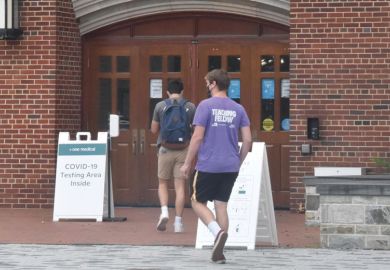The wealth divide in US higher education appears to be widening even more this academic year, with a series of selective institutions reporting record enrolments while many others struggle to serve lower-income students.
Nationwide autumn semester enrolment data from the official source, the National Student Clearinghouse, are at least a month away. But one dimension is becoming evident in the form of elite campuses celebrating all-time highs in acceptances of admission offers.
They include Brown University, which attributed its record yield of 69 per cent to high-quality teaching, campus beauty and generous financial aid. Rice University, with a record class size and yield rate, credited its focus on international recruitment. Tufts University said its “holistic, contextual review of each application” helped create its largest-ever class.
Some top public institutions, including the University of California system and the University of Illinois, also have been touting record autumn numbers.
Beyond those upper tiers, however, confidence was scarcer. A long-standing area of concern has been smaller tuition-dependent private colleges, and few of those are immediately highlighting their class sizes. Among those that are, a common strategy appears to have involved deeply discounting fees and hoping their budgets balance.
The hardest-hit corner of academia during the pandemic remains community colleges, which saw freshmen enrolment last autumn decline 19 per cent from the previous year. Two-year institutions might now be seeing some recovery, according to the American Association of Community Colleges, though it’s too early to be sure.
“We have heard that, in many places, campus enrolments appear to be bouncing back from the last year, with increased numbers of students or at least no further declines,” said David Baime, the association’s senior vice-president for government relations. “However, this is far from universal.”
The US is experiencing a general decline in the number of college-age students. More immediate enrolment problems, however, are seen as largely stemming from Covid – both as a disease and as an economic burden – ravaging the poorest communities of a nation that already had been marked by wide wealth gaps and families unable to afford college.
Many elite universities are citing gains in the racial and economic diversity of their large new freshmen classes, due largely to their reduced reliance on standardised admissions tests and their expansions of financial aid packages.
The California system, which eliminated the use of SAT and ACT test scores in its admissions decisions, said that its largest and most diverse class drew nearly half its members from low-income families.
Historically black colleges are also enjoying a renaissance, attributing it in part to rising racial awareness growing out of the George Floyd killing and the election of Kamala Harris as vice-president.
But for the larger masses of less-advantaged US school-leavers, it may not be enough. Data compiled by the National College Attainment Network showed that applications for federal financial aid – a key marker of interest among lower-income students – fell nearly 5 per cent for this autumn’s intake.
The declines in aid applications were even sharper in populations of minority and low-income backgrounds, the group said.
“That’s very concerning,” said Doug Shapiro, executive director for research at the National Student Clearinghouse.
“That’s the low-income students, the disadvantaged students, who’ve already been hardest hit to begin with in the pandemic, and they look like they’re not on track for a rebound.”
Register to continue
Why register?
- Registration is free and only takes a moment
- Once registered, you can read 3 articles a month
- Sign up for our newsletter
Subscribe
Or subscribe for unlimited access to:
- Unlimited access to news, views, insights & reviews
- Digital editions
- Digital access to THE’s university and college rankings analysis
Already registered or a current subscriber?








